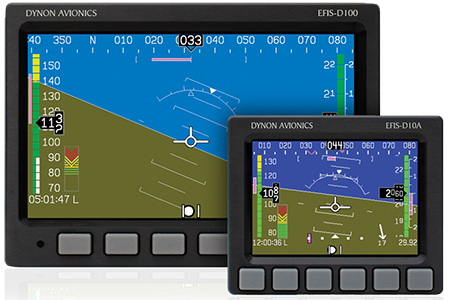EAA Improves General Aviation Safety
By Ian Brown, EAA 657159, Editor and Canadian Council Board Member
February 2017 - In general, EAA has a mission to improve aviation safety. This can be seen in the many forums and publications dedicated to the topic. One area of specific interest to many GA pilots are the STCs allowing the Dynon EFIS-10A or EFIS-D100 (7-inch widescreen) to be used as a replacement for the traditional attitude indicator in a certificated aircraft. The D10A footprint is compatible with the standard instrument hole, although you may have to check for about 9 inches of clearance behind the hole, including the space for static, angle of attack, and pitot lines to be run.

Many of our readers will remember the cautions about what to do if the vacuum-driven attitude indicator becomes stuck during upset recovery. This can be particularly alarming if the pilot happens to be in IMC conditions at the time. Many older autopilots depend on inputs from the attitude indicator too, and anyone practising aerobatics may be familiar with the idea that vacuum-operated attitude indicators do not like to go beyond 100 degrees of bank and 60 degrees of pitch before hitting the stops.
Our readers may not know that solid-state attitude indicators, like those in the Dynon products, not only benefit from the absence of a vacuum-driven gyro but also from the fact that solid-state gyros cannot be upset. This means that you can boast a partial “glass cockpit,” and also rest assured that you have taken steps to improve your safety.
Once the D10A or D100 is installed, you also have a backup for several other instruments in the panel. Both products feature attitude, airspeed, altitude, and turn-rate indicators, an inclinometer, a G-meter, up/down timers, a clock, and a voltmeter. Battery backup provides power in event of aircraft electrical system failure. Other optional capabilities include angle of attack, magnetic heading, OAT, true airspeed, winds aloft, and density altitude.
The EAA STC can be checked out either at the EAA website or at Dynon Avionics, where you will also find a continuously updated list of certificated aircraft to which the STC applies. The recently updated approved model list now covers many Cessna, Piper, Beechcraft, Grumman, Mooney, and Maule models.
EAA began with a mission of encouraging amateur building of aircraft, but today’s focus on safety reaches a much wider audience. In eight years of using the D10A, the author has never had an in-flight failure of the D10A, and with the battery backup option, these devices provide an extra safety net if you lose electrical power, especially at night. It would take a copy of the users manual to explain all of the features, but there are some nonobvious additional features like configurable pitch, roll indicators and checklists, configurable audio-alarms, and a calibration feature for the heading indicator, which make the day-to-day use a lot more intuitive. You don’t need a compass calibration card with this puppy!
In the author’s opinion, the heading indicator is more reliable, the angle of attack indicator is a significant safety feature, and the G-meter is a useful measure of how bumpy that last flight actually was. The overall convenience of having the whole “six pack” on one compact, always-lit screen is amazing. If this isn’t enough to convince you that EAA is having an impact in general aviation safety, then maybe the price of US$2,625 will encourage you to consider it relative to more expensive upgrades that may not bring the same level of safety improvement to you and your loved ones.
